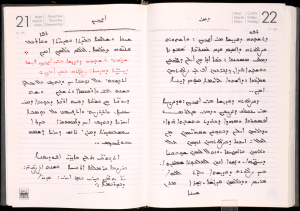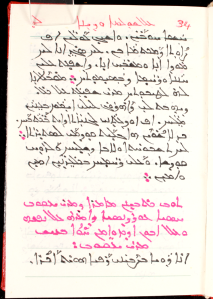 The word “manuscript” conjures images of monks, quills, parchment, candles, and the like, that is, a mostly pre-modern setting and seemingly antiquated accoutrements, but the advent and proliferation of the printing press was hardly a death knell to writing by hand, neither in the fifteenth century, nor in those following (keyboards, physical or on-screen, notwithstanding). We don’t have to go back as far as some pre-modern period in Europe or elsewhere to find manuscripts (which, remember, simply means anything written by hand) as a notable witness to scholarly, creative, or memorial activity, and we are not talking here only of texts in old (Greek, Sanskrit, etc.) or semi-old (e.g. Middle English, Ottoman Turkish) varieties of language. Consider the “papers” (in French, English, and other contemporary languages) of relatively recent authors, such as James Joyce and others, which are very often handwritten. (Following widespread use of the typewriter, typewritten pages and sometimes even electronically produced documents are sometimes misleadingly referred to as “manuscripts”!) True, these documents are typically not copied and recopied: for that, printing was employed, and sometimes — if the assumed circulation was (or, prior to efforts by publishers such as Barney Rosset of Grove Press, had to be) small — private printing, one catalog of which is here, and which on the first page has the titles Double Acrostic Enigmas, with Poetical Descriptions selected principally from British Poets and Feigned Insanity, how most usually simulated, and how best detected! From Syriac studies we may point to Gottheil’s (age 23 at the time) little book to the right. (Thankfully, many of these privately printed books are now easily available online for a wide audience.)
The word “manuscript” conjures images of monks, quills, parchment, candles, and the like, that is, a mostly pre-modern setting and seemingly antiquated accoutrements, but the advent and proliferation of the printing press was hardly a death knell to writing by hand, neither in the fifteenth century, nor in those following (keyboards, physical or on-screen, notwithstanding). We don’t have to go back as far as some pre-modern period in Europe or elsewhere to find manuscripts (which, remember, simply means anything written by hand) as a notable witness to scholarly, creative, or memorial activity, and we are not talking here only of texts in old (Greek, Sanskrit, etc.) or semi-old (e.g. Middle English, Ottoman Turkish) varieties of language. Consider the “papers” (in French, English, and other contemporary languages) of relatively recent authors, such as James Joyce and others, which are very often handwritten. (Following widespread use of the typewriter, typewritten pages and sometimes even electronically produced documents are sometimes misleadingly referred to as “manuscripts”!) True, these documents are typically not copied and recopied: for that, printing was employed, and sometimes — if the assumed circulation was (or, prior to efforts by publishers such as Barney Rosset of Grove Press, had to be) small — private printing, one catalog of which is here, and which on the first page has the titles Double Acrostic Enigmas, with Poetical Descriptions selected principally from British Poets and Feigned Insanity, how most usually simulated, and how best detected! From Syriac studies we may point to Gottheil’s (age 23 at the time) little book to the right. (Thankfully, many of these privately printed books are now easily available online for a wide audience.)
“Manuscript culture” in the fullest sense refers not to a specific time, place, or language, but to the production and re-production (i.e. copying) of manuscripts. Taken thus, it is certainly most predominant in pre-modern periods, at least in Europe, but in the Middle East and parts of Africa (Ethiopia) — what about China, India, elsewhere? — copying texts has remained, at least in some small circles, a real practice. HMML has copies of very many Gǝʿǝz manuscripts from the 20th century, and likewise for manuscripts in Syriac, Arabic, and Garšūnī. Just from Mardin, and just in Syriac, HMML has copies of more than 80 manuscripts from the 20th century. The 1960s, it seems, were a relatively active period, with some large manuscripts copied then. As my colleague Wayne Torborg pointed out, someone may have been copying the words of Genesis in Syriac while, perhaps unbeknownst to them, those words in English were being recited from Apollo 8 on Christmas Eve, 1968! While these late manuscripts may often — but hardly always! — be of limited value as textual witnesses, in terms of the manuscript as a physical product and in terms of examples of scribal activity, their worth is not at all negligible, not even to mention their colophons and readers’ notes, which are eminently unique. Also, I have talked before about the probable importance of reading handwriting (i.e. manuscripts) and practicing handwriting (copying manuscripts) in language learning (see here and here), and in the second place I pointed to certain nineteenth- and twentieth-century orientalists who seemingly used manuscript copying to good effect. So at least some manuscript copying was going on also among European scholars.
Within this context and this definition of “manuscript culture”, I would like to highlight a very recently copied manuscript from the latest batch of files from Saint Mark’s Monastery in Jerusalem. I had seen manuscripts with notes written in Syriac dated as late as 2008, and a very interesting manuscript that I doubt I shall ever forget is a collection of three saints’ lives copied into a 1993 calendar book (ZFRN 385), but based on a manuscript on parchment from 1496 AG (= 1184/5 CE)!
As unique as that manuscript is, the great lateness of the Jerusalem manuscript (SMMJ 475) is also startlingly memorable. It has the date in three places, all from the present year, the last one being July 26, 2012! Copied by the monk, Shemun Can, at Saint Mark’s, it is a collection of Syriac poetry, mostly by later authors (but one by Jacob of Serugh and one by Ephrem), along with a few hymns in Garšūnī and the Lawij (in Kurdish with Syriac letters) of Basilios Šemʿon al-Ṭūrānī. The manuscript’s colophons are all in a style not unlike those written centuries before, and they, together with the manuscript as a whole, a physical, textual object, remind us well that manuscript culture, at least in some quarters, is alive and well.




